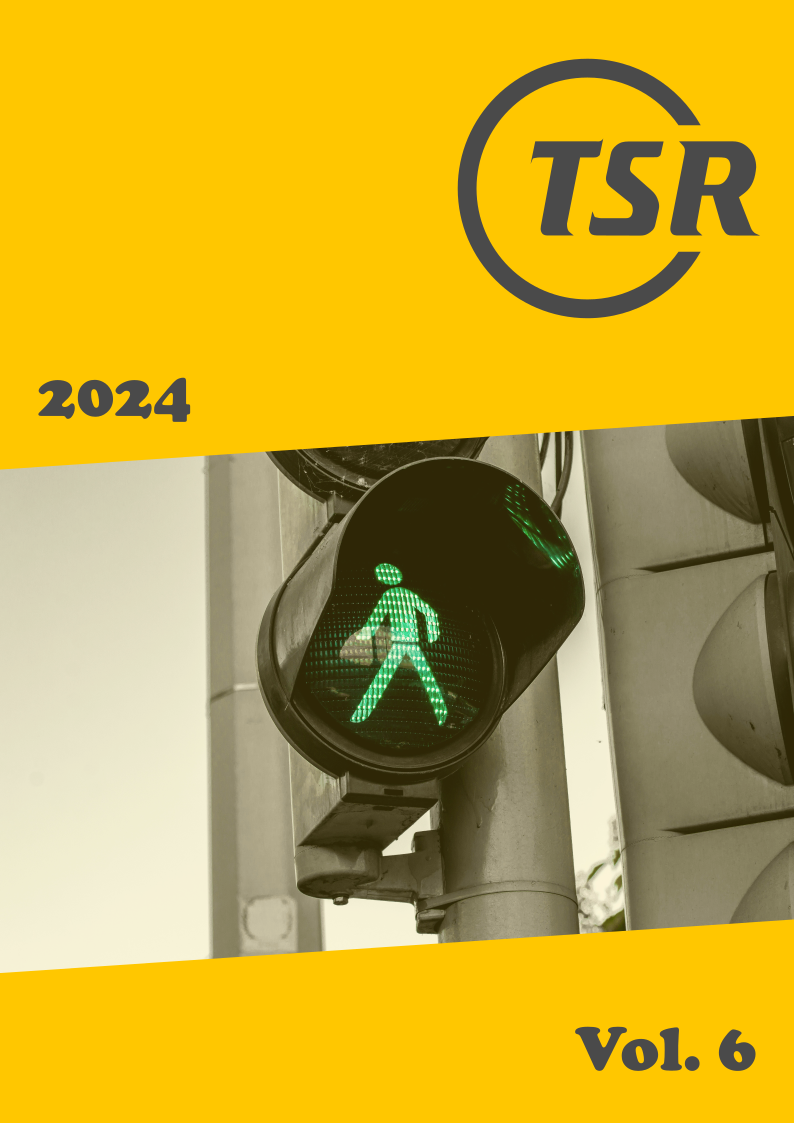The safety effect of increased pedestrian protection, autonomous emergency braking for pedestrians and bicyclists on passenger cars, and speed management
DOI:
https://doi.org/10.55329/hbtq4489Keywords:
AEB with cyclist detection, AEB with pedestrian detection, Euro NCAP, pedestrian protection, speed managementAbstract
This was the first retrospective study to estimate the effect of increased pedestrian protection, autonomous emergency braking, and speed management to reduce serious injuries among pedestrians and bicyclists. More specifically, the aim was to estimate the injury mitigating effects of the following interventions: AEB with pedestrian and bicyclist detection, Euro NCAP pedestrian test score, active bonnet, traffic calming at pedestrian and bicycle crossings, and additionally, the combined effect of the above-mentioned treatments. The main source of data was the Swedish traffic data acquisition system (Strada), where information of road traffic crashes between passenger cars and pedestrians or bicyclists for the period 1 January 2003–31 December 2022 was obtained. Cars with optional fitment of AEB systems were identified, and the license registration number was used to access individual car equipment lists to identify whether the vehicle was equipped with AEB with pedestrian and/or cyclist detection. Information about traffic calming at pedestrian and bicycle crossings was obtained from the Swedish Transport Administration. The injury metric used was risk of permanent medical impairment (RPMI) of at least one percent and ten percent. RPMI captures the risk of long-term medical impairment based on a diagnosed injury location and Abbreviated Injury Severity (AIS) score. The relative difference between the mean values of RPMI (mRPMI1%+ and mRPMI10%+) was calculated and tested using an independent two sample t-test which was conducted for unequal sample sizes and variance. Although many results were found to be statistically non-significant, the following results were found to be significant at least at 90% level. Pedestrian mRPMI10%+ was reduced by 44% in speed zones ≤ 50 km/h comparing the group struck by cars equipped with AEB with pedestrian detection compared to the group struck by cars without the system. For cyclists, the mRPMI10%+ was reduced by 35% in speed zones ≤ 50 km/h. For crashes within ± 20 meters from a pedestrian or bicycle crossing, the AEB system reduced 60% of pedestrians mRPMI10%+ at crossings with good safety standard compared to crossings of poor safety standard. The comparison of cars with poor performance (1–9 points) in the NCAP pedestrian test and cars with a high score (28–36 points) showed that pedestrian mRPMI10%+ was reduced by 48% across all speed limits, and by 64% including only those aged ≤ 64 years. For bicyclists, a significant reduction of cyclist mRPMI10%+ was found comparing low scoring cars to high scoring cars in ≤ 30 km/h speed limit (-73%) and across all speed limits (-36%). Including only those aged ≤ 64 years, the reduction was 49%. For the active bonnet, a significant reduction of mRPMI1%+ by 24% was observed but given that the rate of helmet wearing was higher in the group struck by cars with active bonnet, this difference cannot be attributed to an effect of an active bonnet. The STA safety rating of pedestrian and bicycle crossings showed that overall pedestrian mRPMI1%+ was reduced by 15%, while cyclists mRPMI10%+ was reduced by 32% comparing crossings of high safety level to crossings of poor safety level. The analysis of combined interventions showed that the total reduction of pedestrians and cyclists mRPMI10%+ together was 69%, from 6.4% to 2%. This paper demonstrates that a road environment with adapted infrastructure and speed, combined with passenger car technologies that improve the safety for vulnerable road users, can create significant reductions of serious (long-term) injuries among pedestrians and bicyclists.
Downloads
References
Agerholm, N., D. Knudsen, K. Variyeswaran (2017), 'Speed-calming measures and their effect on driving speed-test of a new technique measuring speeds based on GNSS data', Transportation Research Part F: Traffic Psychology and Behaviour, 46, 263–270. DOI: https://doi.org/10.1016/j.trf.2016.06.022
Amin, K., M. Skyving, C. Bonander, M. Krafft, F. Nilson (2022), 'Fall- and collision-related injuries among pedestrians in road traffic environment: A Swedish national register-based study', Journal of Safety Research, 81, 153–165. DOI: https://doi.org/10.1016/j.jsr.2022.02.007
Berg, H. Y., J. Ifver, M. Hasselberg (2016), 'Public health consequences of road traffic injuries - Estimation of seriously injured persons based on risk for permanent medical impairment', Transportation Research Part F: Traffic Psychology and Behaviour, 38, 1–6. DOI: https://doi.org/10.1016/j.trf.2015.12.007
Bil, M., M. Bilova, M. Dobias, R. Andrasik (2016), 'Circumstances and causes of fatal cycling crashes in the Czech Republic', Traffic Injury Prevention, 17(4), 394–399. DOI: https://doi.org/10.1080/15389588.2015.1094183
Cicchino, J. B. (2022), 'Effects of automatic emergency braking systems on pedestrian crash risk', Accident Analysis & Prevention, 172, 106686. DOI: https://doi.org/10.1016/j.aap.2022.106686
Cripton, P. A., H. Shen, J. R. Brubacher, M. Chipman, S. M. Friedman, M. A. Harris, M. Winters, C. C. O. Reynolds, M. D. Cusimano, S. Babul, K. Teschke (2015), 'Severity of urban cycling injuries and the relationship with personal, trip, route and crash characteristics: analyses using four severity metrics', BMJ Open, 5(1), e006654. DOI: https://doi.org/10.1136/bmjopen-2014-006654
Elvik, R. (2009), 'An exploratory analysis of models for estimating the combined effects of road safety measures', Accident Analysis & Prevention, 41(4), 876–880. DOI: https://doi.org/10.1016/j.aap.2009.05.003
Euro NCAP, (2023), 'Glossary'.
Försäkringsförbundet, (2004), 'Medicinsk invaliditet', Svensk försäkning.
Gyaase, D., S. Newton, C. A. Adams, Y. Emuameh, B. N. Adjel, E. K. Nakua (2023), 'Effect of speed bumps on injury consequences on trunk roads traversing towns in Ghana: A quasi-experimental study', Injury Prevention, 29(1), 68–73. DOI: https://doi.org/10.1136/ip-2022-044598
Howard, C., A. Linder (2014), 'Review of Swedish experiences concerning analysis of people injured in traffic accidents', Swedish National Road and Transport Research Institute, VTI notat 7A–2014.
Hurtig, P., P. Larsson, M. Lindholm, M. Rizzi, S. Sternlund, A. Elmqvist, R. Fredriksson, Å. Forsman, A. Vadeby, K. Amin (2022), 'Analysis of road safety trends 2022', Swedish Transport Administration.
Isaksson-Hellman, I., M. Lindman (2019), 'Real-world evaluation of driver assistance systems for vulnerable road users based on insurance crash data in Sweden', 26th International Technical Conference on the Enhanced Safety of Vehicles (ESV), Eindhoven, the Netherlands, 10–13 June 2019.
Isaksson-Hellman, I., M. Lindman (2023), 'Estimating the crash reducing effect of Advanced Driver Assistance Systems (ADAS) for vulnerable road users', Traffic Safety Research, 4, 000036. DOI: https://doi.org/10.55329/blzz2682
Johansson, R. (2009), 'Vision Zero - Implementing a policy for traffic safety', Safety Science, 47(6), 826–831. DOI: https://doi.org/10.1016/j.ssci.2008.10.023
Kullgren, A., K. Amin, C. Tingvall (2023), 'Effects on crash risk of automatic emergency braking systems for pedestrians and bicyclists', Traffic Injury Prevention, 24, 111–115. DOI: https://doi.org/10.1080/15389588.2022.2131403
Lee, G., S. Joo, C. Oh, K. Choi (2013), 'An evaluation framework for traffic calming measures in residential areas', Transportation Research Part D: Transport and Environment, 25, 68–76. DOI: https://doi.org/10.1016/j.trd.2013.08.002
Leslie, A. J., R. J. Kiefer, C. A. Flannagan, S. H. Owen, B. A. Schoettle (2022), 'Analysis of the field effectiveness of General Motors model year 2013-2020 advanced driver assistance system features', University of Michigan Transportation Research Institute (UMTRI).
Leslie, A. J., R. J. Kiefer, M. R. Meitzner, C. A. Flannagan (2021), 'Field effectiveness of General Motors advanced driver assistance and headlighting systems', Accident Analysis & Prevention, 159, 106275. DOI: https://doi.org/10.1016/j.aap.2021.106275
Lubbe, N., Y. Wu, H. Jeppsson (2022), 'Safe speeds: fatality and injury risks of pedestrians, cyclists, motorcyclists, and car drivers impacting the front of another passenger car as a function of closing speed and age', Traffic Safety Research, 2, 000006. DOI: https://doi.org/10.55329/vfma7555
Lundberg, E., L. Ekman (2016), 'Säkerhetsklassificering av vägnät [Safety classification of the road network]', Swedish Transport Administration, 2017:103.
Malm, S., M. Krafft, A. Kullgren, A. Ydenius, C. Tingvall (2008), 'Risk of permanent medical impairment (RPMI) in road traffic accidents', Annals of Advances in Automotive Medicine, 52, 93–100.
Naci, H., D. Chisholm, T. D. Baker (2009), 'Distribution of road traffic deaths by road user group: a global comparison', Injury Prevention, 15, 55–59. DOI: https://doi.org/10.1136/ip.2008.018721
Ohlin, M., B. Alguren, A. Lie (2019), 'Analysis of bicycle crashes in Sweden involving injuries with high risk of health loss', Traffic Injury Prevention, 20(6), 613–618. DOI: https://doi.org/10.1080/15389588.2019.1614567
Ohlin, M., J. Strandroth, C. Tingvall (2017), 'The combined effect of vehicle frontal design, speed reduction, autonomous emergency braking and helmet use in reducing real life bicycle injuries', Safety Science, 92, 338–344. DOI: https://doi.org/10.1016/j.ssci.2016.05.007
Pucher, J., J. Dill, S. Handy (2010), 'Infrastructure, programs, and policies to increase bicycling: an international review', Preventive Medicine, 50, 106–125. DOI: https://doi.org/10.1016/j.ypmed.2009.07.028
Quigley, C. (2017), 'Installation of Speed Bumps', SafetyCube DSS.
Rizzi, M., A. Kullgren, C. Tingvall (2016), 'The combined benefits of motorcycle antilock braking systems (ABS) in preventing crashes and reducing crash severity', Traffic Injury Prevention, 17(3), 297–303. DOI: https://doi.org/10.1080/15389588.2015.1061660
Rizzi, M., H. Stigson, M. Krafft (2013), 'Cyclist injuries leading to permanent medical impairment in Sweden and the effect of bicycle helmets', International Research Council on Biomechanics of Injury (IRCOBI), IRCOBI, Gothenburg, 11–13 September 2013.
Rosen, E., U. Sander (2009), 'Pedestrian fatality risk as a function of car impact speed', Accident Analysis & Prevention, 41(3), 536–542. DOI: https://doi.org/10.1016/j.aap.2009.02.002
Rosen, E., H. Stigson, U. Sander (2011), 'Literature review of pedestrian fatality risk as a function of car impact speed', Accident Analysis & Prevention, 43(1), 25–33. DOI: https://doi.org/10.1016/j.aap.2010.04.003
Spicer, R., A. Vahabaghaie, D. Murakhovsky, G. Bahouth, B. Drayer, S. St. Lawrence (2021), 'Effectiveness of Advanced Driver Assistance Systems in Preventing System-Relevant Crashes', SAE International Journal of Advances and Current Practices in Mobility, 3(4), 1697–1701. DOI: https://doi.org/10.4271/2021-01-0869
Sternlund, S. (2011), 'Korrelationen mellan fotgängares skador i verkliga olyckor och Euro NCAPs testresultat för fotgängarskydd', PhD thesis, Linköping universitet, Linköping, Ph.D dissertation.
Stigson, H., A. Kullgren, E. Rosen (2012), 'Injury risk functions in frontal impacts using data from crash pulse recorders', Annals of Advances in Automotive Medicine, 56, 267–276.
Strandroth, J., M. Rizzi, S. Sternlund, A. Lie, C. Tingvall (2011), 'The correlation between pedestrian injury severity in real-life crashes and Euro NCAP pedestrian test results', Traffic Injury Prevention, 12(6), 604–613. DOI: https://doi.org/10.1080/15389588.2011.607198
Strandroth, J., S. Sternlund, A. Lie, C. Tingvall, M. Rizzi, A. Kullgren, R. Fredriksson (2014), 'Correlation Between Euro NCAP Pedestrian Test Results and Injury Severity in Injury Crashes with Pedestrians and Bicyclists in Sweden', SAE Technical Paper Series, 58, 213–231. DOI: https://doi.org/10.4271/2014-22-0009
Tingvall, C., N. Haworth (1999), 'Vision Zero - An ethical approach to safety and mobility', 6th ITE International Conference Road Safety & Traffic Enforcement: Beyond 2000, Melbourne, Australia, 6–7 September 1999.
Transportstyrelsen, (2023), 'Om olycksdatabasen Strada', Transportstyrelsen.
Wisch, M., M. Lerner, E. Vukovic, D. Hynd, A. Fiorentino, A. Fornells (2017), 'Injury Patterns of Older Car Occupants, Older Pedestrians or Cyclists in Road Traffic Crashes with Passenger Cars in Europe - Results from SENIORS', International Research Council on Biomechanics of Injury (IRCOBI) Conference, Antwerp, Belgium, 13–15 September 2017.
Downloads
Published
How to Cite
Issue
Section
License
Copyright (c) 2024 Maria C. Rizzi, Khabat Amin, Johan Strandroth, Simon Sternlund, Rikard Fredriksson, Anders Kullgren

This work is licensed under a Creative Commons Attribution 4.0 International License.
Funding data
-
Trafikverket
Grant numbers TRV 2021-52715













